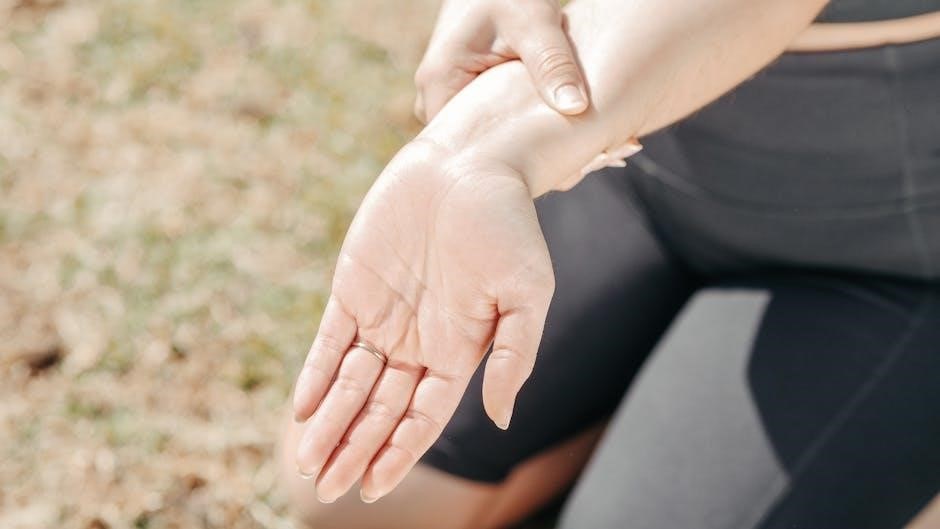
Lower back pain is a common issue affecting millions worldwide, often caused by muscle strain or poor posture. Sciatica, a specific type of radiating pain, occurs when the sciatic nerve is irritated, leading to symptoms like numbness, tingling, and discomfort in the legs. Both conditions can significantly impact daily activities, but targeted exercises can help alleviate symptoms and improve mobility. Always consult a healthcare professional before starting any exercise program.
1.1 Understanding Sciatica and Its Symptoms
Sciatica is a type of radiating pain caused by irritation of the sciatic nerve, which runs from the lower back to the legs. Symptoms include sharp shooting pain, numbness, tingling, and burning sensations in the buttocks, hips, and legs. It often results from muscle strain, herniated discs, or spinal issues. While exercises can help relieve symptoms, understanding the root cause is crucial for effective management. If symptoms persist or worsen, consulting a healthcare professional is essential to avoid further complications. Proper diagnosis ensures targeted treatment, enhancing the effectiveness of exercises and other therapies.
1.2 The Importance of Exercise in Managing Lower Back Pain
Exercise plays a crucial role in managing lower back pain and sciatica by strengthening muscles, improving flexibility, and enhancing posture. Regular physical activity can reduce pain intensity, prevent recurrence, and promote long-term recovery. Stretching and strengthening exercises target specific muscle groups, alleviating tension and stabilizing the spine. A tailored exercise program, guided by a healthcare professional, ensures safety and effectiveness, addressing the root cause of pain. Consistency is key, as it helps maintain muscle strength and prevents future injuries, enabling individuals to resume daily activities with greater ease and confidence. Always consult a professional before starting any new routine.

Stretching Exercises for Sciatica Relief
Stretching exercises are essential for sciatica relief, as they reduce muscle tension and improve mobility. They target the lower back, hips, and legs, promoting relaxation and flexibility.
2.1 Single Knee to Chest Stretch
The Single Knee to Chest Stretch is an effective exercise for sciatica relief. Lie on your back and gently pull one knee toward your chest until a comfortable stretch is felt in the lower back and hip. Hold the position for 20-30 seconds, then release and repeat with the other leg; This stretch helps relax tight muscles, improve flexibility, and reduce sciatic nerve pressure. Perform 2-3 sets daily to enhance its benefits. Ensure smooth movements and avoid bouncing to prevent further strain. Always prioritize comfort and stop if sharp pain occurs.
2.2 Piriformis Stretch (Figure Four)
The Piriformis Stretch, also known as Figure Four, targets the piriformis muscle near the sciatic nerve. To perform, lie on your back, cross one leg over the other, and gently pull the knee toward your chest until a stretch is felt in the buttock. Hold for 20-30 seconds and repeat on the opposite side. This stretch helps relieve sciatic nerve pressure and improve hip flexibility. Perform 2-3 sets daily to maximize benefits. Avoid bouncing or forcing the stretch beyond a comfortable range. If sharp pain occurs, discontinue the exercise and consult a healthcare professional. Regular practice can significantly reduce sciatica symptoms.

Strengthening Exercises for Lower Back Pain
Strengthening exercises target core and back muscles to improve posture and reduce pain. Pelvic tilts and glute bridges are effective for building stability and relieving strain. Regular practice enhances muscle endurance and supports long-term pain management. Always perform exercises with proper technique to avoid injury. Consulting a healthcare professional ensures exercises align with individual needs.
3.1 Pelvic Tilt Exercise
The pelvic tilt is a foundational exercise for strengthening the lower back and improving posture. Lie on your back with knees bent and feet flat on the floor. Engage your core by drawing your belly button toward your spine. Slowly tilt your pelvis backward, flattening your lower back against the floor, and hold for 5 seconds. Repeat this motion 10-15 times, breathing naturally. This exercise strengthens the abdominal muscles and relieves tension in the lumbar region. Proper form is essential to avoid strain. Gradually increase repetitions as strength improves. Always consult a healthcare professional before starting new exercises.
3.2 Glute Bridge Exercise
The glute bridge is an effective exercise for strengthening the glutes and lower back muscles, which can help alleviate sciatica symptoms. Lie on your back with knees bent and feet flat on the floor. Slowly squeeze your buttocks and lift your hips toward the ceiling, keeping your shoulders on the ground. Hold for 2-3 seconds at the top, then lower your hips back down. Repeat for 10-15 repetitions. This exercise targets the gluteus maximus and hamstrings, improving posture and reducing strain on the lower back. For those with sciatica, this can help reduce nerve pressure. Always maintain proper form to avoid injury.
Flexibility Exercises for Sciatica
Flexibility exercises improve mobility and reduce stiffness in the lower back and legs. They target tight muscles, enhancing range of motion and alleviating sciatica symptoms. Regular practice is essential.
4.1 Cat-Cow Stretch
The Cat-Cow Stretch is a gentle exercise that improves spinal flexibility and relieves tension in the lower back. Start on your hands and knees in a tabletop position. Inhale as you arch your back, lifting your head and tailbone (Cow Pose). Exhale as you round your spine, tucking your chin and pelvis (Cat Pose). Repeat 10-15 times. This stretch can be modified to suit your comfort level and is particularly effective for sciatica relief. It helps maintain spinal mobility and reduces stiffness without putting excessive strain on the muscles. Regular practice is recommended.
4.2 Hamstring Stretch
The Hamstring Stretch targets the muscles at the back of the thighs, which often contribute to lower back pain and sciatica. Sit on the floor with your legs extended straight in front of you. Loop a towel or strap around the ball of one foot and gently pull your toes toward your chest until a stretch is felt in the back of your leg. Hold for 20-30 seconds and repeat on the other side. Avoid bouncing, as it may cause muscle strain. Perform this stretch twice daily to improve flexibility and reduce sciatica-related discomfort. Regular practice can help alleviate tightness in the hamstrings.
Safe Exercise Practices for Sciatica
Prioritize proper form to avoid injury during exercises. Start slowly, ensuring movements are controlled and pain-free. Stop immediately if sharp pain occurs. Modify exercises to suit your comfort level. Always warm up before beginning and cool down afterward. Breathing naturally and avoiding forceful movements is crucial. Focus on gentle stretches and strengthening exercises. If unsure, consult a healthcare professional to tailor exercises to your specific condition. This ensures a safe and effective approach to managing sciatica and lower back pain.
Proper technique is essential when performing exercises for lower back pain and sciatica. Always maintain a neutral spine to prevent further injury; Engage core muscles to stabilize the body during movements. Avoid bouncing or forcing stretches beyond a comfortable range. If an exercise causes sharp pain, stop immediately. Focus on slow, controlled movements to ensure safety and effectiveness. Using props like pillows or mats can help maintain proper alignment. Consult a healthcare professional to learn correct form and modify exercises based on individual needs. Prioritizing technique helps maximize benefits while minimizing the risk of aggravating the condition. A daily routine includes pelvic tilts to warm up, followed by glute bridges and cat-cow stretches for flexibility. Finish with hamstring stretches to relieve tension. Morning routines should focus on gentle stretches to improve mobility. Begin with pelvic tilts and cat-cow stretches to loosen the spine. Follow with hamstring stretches to relieve tension in the lower back. In the evening, incorporate glute bridges to strengthen the core and piriformis stretches to target the buttocks. Each exercise should be held for 20-30 seconds and repeated 2-3 times. End both routines with deep breathing to promote relaxation and reduce muscle stiffness. Consistency in these routines can significantly improve posture and reduce sciatica-related discomfort. Always prioritize proper technique to avoid further strain. Find printable PDF guides and instructional videos online for lower back pain and sciatica exercises. Websites like nyu.edu offer detailed exercise sheets. Consult a musculoskeletal physiotherapist for personalized plans. Printable PDF guides for exercises addressing lower back pain and sciatica are widely available online. Reputable websites like nyu.edu and health clinics offer detailed exercise sheets. These guides often include step-by-step instructions, images, and safety tips. Many physiotherapy websites also provide free downloadable resources. When searching, look for guides endorsed by healthcare professionals to ensure accuracy and safety. Always consult a physiotherapist before starting any new exercise program, especially if you have severe symptoms or underlying conditions. These resources are invaluable for home-based rehabilitation and pain management. Regular exercises and proper techniques can significantly alleviate lower back pain and sciatica. Always consult a healthcare professional to tailor a safe and effective program for long-term relief. Exercise plays a crucial role in managing lower back pain and sciatica long-term. Regular physical activity strengthens core muscles, improving posture and reducing strain on the spine. Stretching exercises, such as the piriformis stretch and cat-cow stretch, enhance flexibility and relieve nerve compression. Strengthening exercises like pelvic tilts and glute bridges stabilize the lower back, preventing future injuries. Consistency is key, as these exercises help maintain mobility and reduce pain over time, promoting an active lifestyle. Always consult a healthcare professional to ensure exercises are performed safely and effectively for optimal results. Consulting a healthcare professional is essential when managing lower back pain and sciatica. They can provide personalized recommendations and ensure exercises are safe and effective for your specific condition. A professional can identify underlying causes, such as herniated discs or muscle imbalances, and tailor a program to address them. They also monitor progress and adjust routines as needed. Improper exercises can worsen symptoms, so expert guidance minimizes risks. Additionally, professionals can offer resources, such as printable PDF guides, to support your exercise routine. Always seek advice before starting a new program to ensure safety and effectiveness.5.1 Proper Technique to Avoid Injury

Sample Exercise Routine for Daily Practice
6.1 Morning and Evening Exercise Routines

Resources for Exercise Guides
7.1 Where to Find Printable PDF Guides
8.1 The Role of Exercise in Long-Term Pain Management
8.2 Importance of Consulting a Healthcare Professional